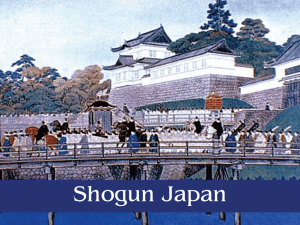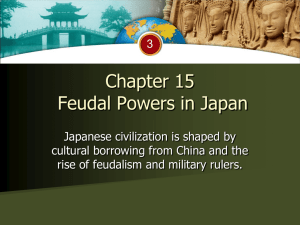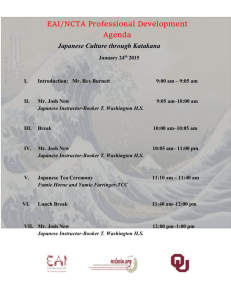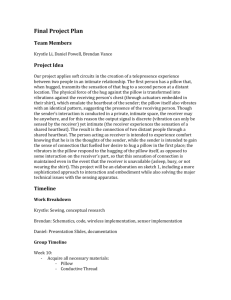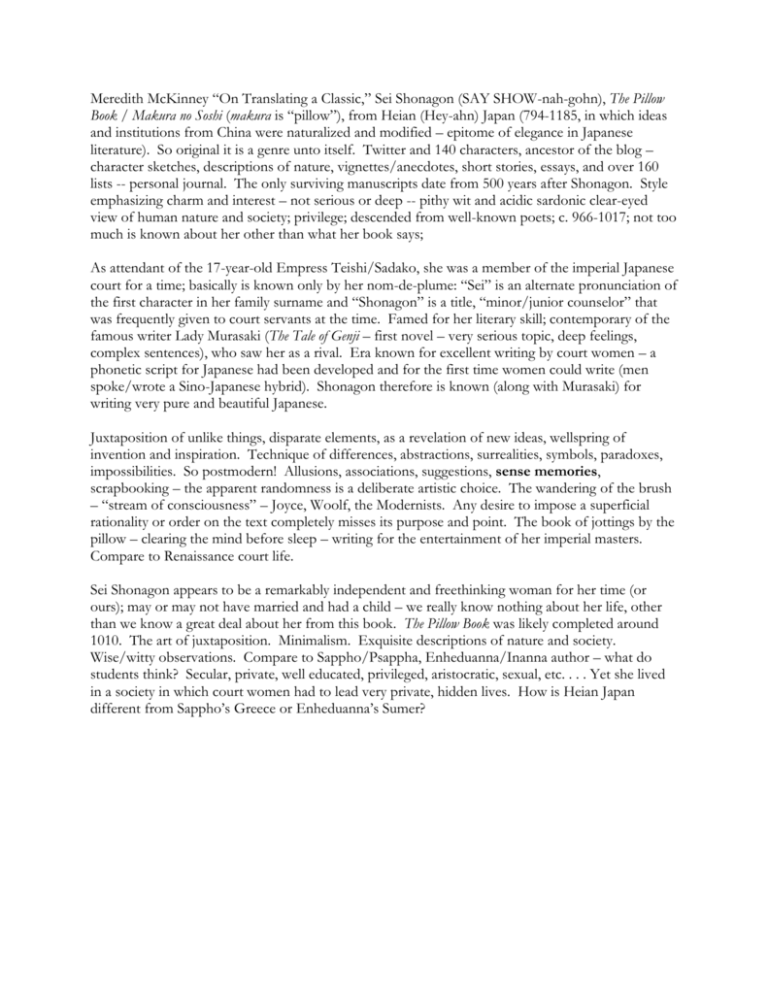
Meredith McKinney “On Translating a Classic,” Sei Shonagon (SAY SHOW-nah-gohn), The Pillow
Book / Makura no Soshi (makura is “pillow”), from Heian (Hey-ahn) Japan (794-1185, in which ideas
and institutions from China were naturalized and modified – epitome of elegance in Japanese
literature). So original it is a genre unto itself. Twitter and 140 characters, ancestor of the blog –
character sketches, descriptions of nature, vignettes/anecdotes, short stories, essays, and over 160
lists -- personal journal. The only surviving manuscripts date from 500 years after Shonagon. Style
emphasizing charm and interest – not serious or deep -- pithy wit and acidic sardonic clear-eyed
view of human nature and society; privilege; descended from well-known poets; c. 966-1017; not too
much is known about her other than what her book says;
As attendant of the 17-year-old Empress Teishi/Sadako, she was a member of the imperial Japanese
court for a time; basically is known only by her nom-de-plume: “Sei” is an alternate pronunciation of
the first character in her family surname and “Shonagon” is a title, “minor/junior counselor” that
was frequently given to court servants at the time. Famed for her literary skill; contemporary of the
famous writer Lady Murasaki (The Tale of Genji – first novel – very serious topic, deep feelings,
complex sentences), who saw her as a rival. Era known for excellent writing by court women – a
phonetic script for Japanese had been developed and for the first time women could write (men
spoke/wrote a Sino-Japanese hybrid). Shonagon therefore is known (along with Murasaki) for
writing very pure and beautiful Japanese.
Juxtaposition of unlike things, disparate elements, as a revelation of new ideas, wellspring of
invention and inspiration. Technique of differences, abstractions, surrealities, symbols, paradoxes,
impossibilities. So postmodern! Allusions, associations, suggestions, sense memories,
scrapbooking – the apparent randomness is a deliberate artistic choice. The wandering of the brush
– “stream of consciousness” – Joyce, Woolf, the Modernists. Any desire to impose a superficial
rationality or order on the text completely misses its purpose and point. The book of jottings by the
pillow – clearing the mind before sleep – writing for the entertainment of her imperial masters.
Compare to Renaissance court life.
Sei Shonagon appears to be a remarkably independent and freethinking woman for her time (or
ours); may or may not have married and had a child – we really know nothing about her life, other
than we know a great deal about her from this book. The Pillow Book was likely completed around
1010. The art of juxtaposition. Minimalism. Exquisite descriptions of nature and society.
Wise/witty observations. Compare to Sappho/Psappha, Enheduanna/Inanna author – what do
students think? Secular, private, well educated, privileged, aristocratic, sexual, etc. . . . Yet she lived
in a society in which court women had to lead very private, hidden lives. How is Heian Japan
different from Sappho’s Greece or Enheduanna’s Sumer?


